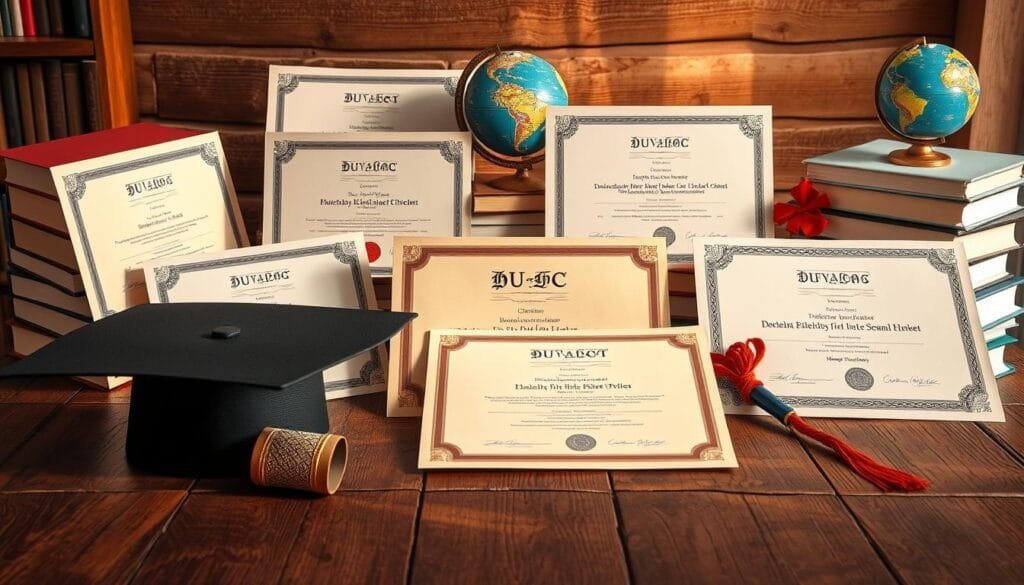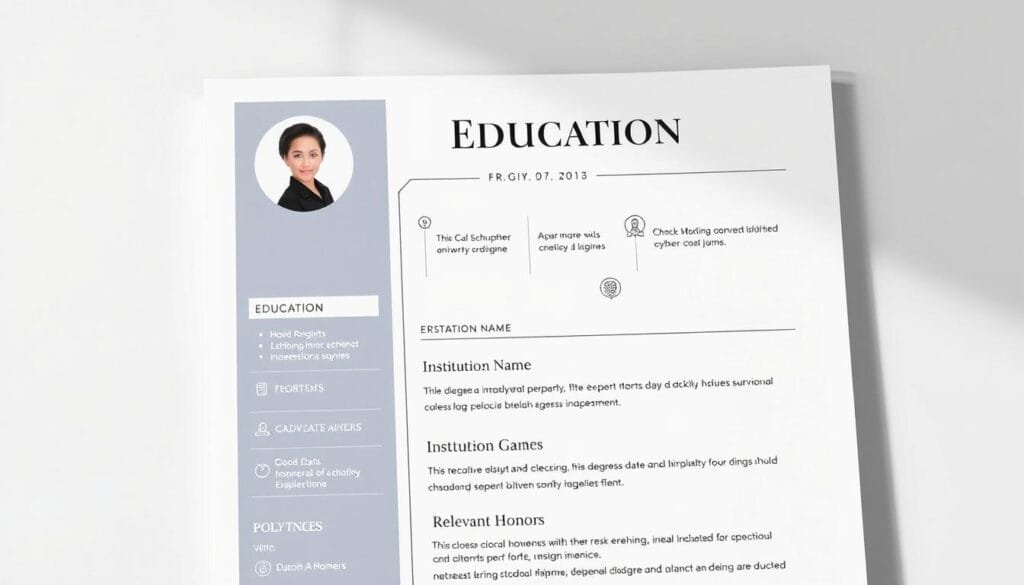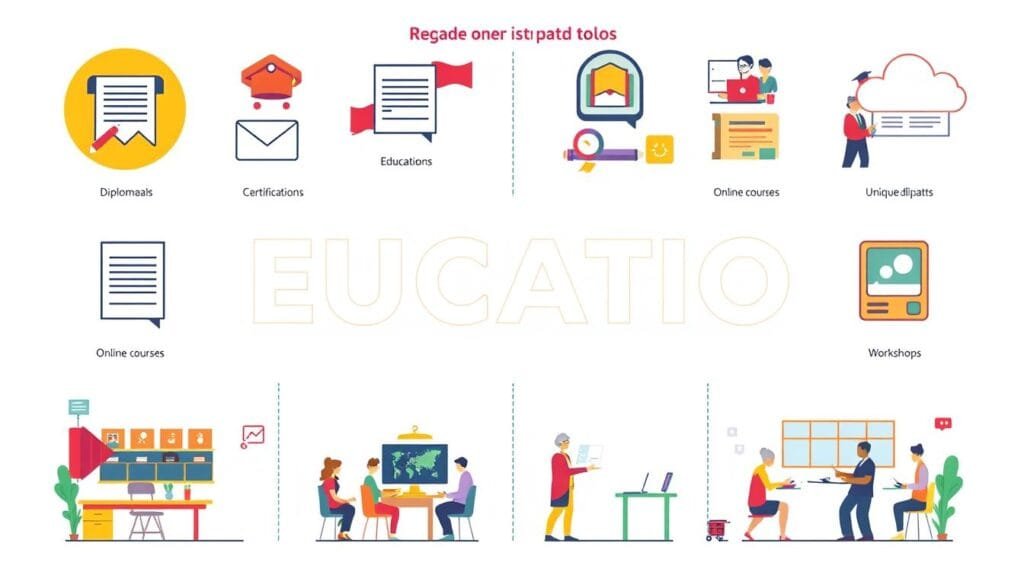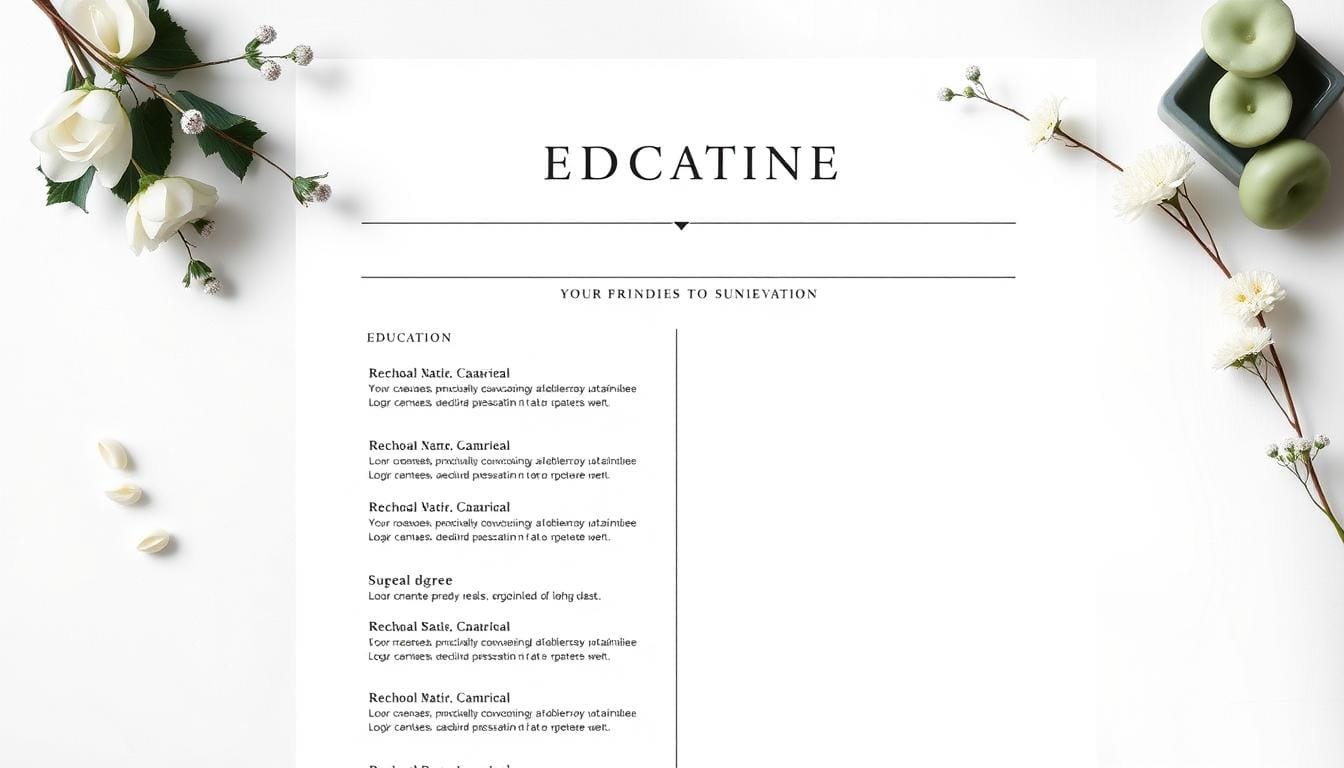The education section of your resume is key. It shows where you’ve been and what you’ve learned. It’s all about lining up your schooling with your job goals. Make sure this part of your resume tells a clear story of your qualifications. Use smart layout tricks to catch an employer’s eye.
If you have a GPA over 3.5, definitely share it. It shows you’re great at handling tough work12. Match your education with the job you want, like a nursing degree for a nursing job1. If you’ve been working for a while, keep your education info to the point and easy to read1. Also, if you’re still in school, mention when you’ll graduate. This avoids any confusion1.
Key Takeaways
- Highlighting a high GPA (>3.5) can underscore strong academic performance.
- Relevance of education to job requirements is crucial for employer interest.
- For experienced individuals, a brief education section maintains resume focus.
- Consistency in formatting aids in the clear presentation of credentials.
- Recent graduates or those with specific degree requirements should feature education prominently.
- Including relevant coursework demonstrates applicable knowledge and skills.
Understanding the Importance of Your Education Section
Your resume’s education section is crucial. It shows potential employers your learning achievements and job skills. This part highlights your knowledge, skills, and your dedication to growing professionally. It also shows you can adapt to different learning settings.
Why Employers Care About Your Education
Employers look at your education to see if you fit the job’s educational needs. If further education is not in your past, listing your high school is key. This is especially true for jobs that ask for a high school diploma3. Also, most resumes (about 67%) have an education section. This shows it’s a common and important part of job applications4. Your academic achievements tell employers you’re ready for the job’s duties.
What Your Education Says About You
Your degrees and courses tell a lot about your ability to learn and improve. It shows you’re not just meeting basic job needs. You’re also capable of picking up new skills helpful in your industry. Showing a high school diploma or current studies means you’re good at handling tasks and overcoming challenges3. Including continuing education or courses—found in 22% of resumes—shows you’re actively seeking to be better4.
Also, how you arrange your education section can show you’re a strategic thinker. Many job seekers (39%) put their education first on their resumes. They use their learning history as a strength from the start4.
How you display your education on your resume can affect how employers view you. It can impact their choice and your career development in turn.
Deciding Where to Position Your Education Section
Deciding where to put your education on your resume is key. It depends on things like how far along you are in your career and how your school work relates to the job you want. For new graduates, showing your schooling at the top is smart. It shines a light on your school successes when job experience is slim5.
If you’ve been working for a while, put education after your job history. This layout shows off your on-the-job skills more than your school background. But if your education is directly needed for the job, make it stand out5. Since hiring managers look at the top part of your resume first, you need to put the most important stuff there. This way, they see what matters right away5.
When arranging your resume, list your degrees starting with the newest first. Make sure to put forward any higher degrees or special certificates, especially if they’re needed for the job. This ensures the hiring person spots the most relevant and recent details first. It helps create a great first impression3.
| Career Stage | Recommended Education Placement | Reason |
|---|---|---|
| Recent Graduate | Top of Resume | Highlight academic achievements, minimal professional experience. |
| Experienced Professional | After Professional Experience | Emphasis on practical skills and experiences relevant to the job. |
| Changing Careers | Top of Resume | Education relevant to new field should be highlighted. |
Improve your resume by checking out tips on how to add education to your resume. It’s good to tailor this section based on the job you’re after and your own career path53.
Key Details to Include for Each Educational Entry
When you write your resume’s education section, it’s key to share your academic qualifications well. You should mention your educational institutions and detail your degree specifics. This makes your resume match the job you want.

Start with the name of the school, then its location. This shows your credentials are solid. If you’re new to the job world, highlight your degree type before the school name. This is vital for jobs like nursing or law16. Experienced folks can just name the school, what degree they got, and where it’s from. This keeps things brief and clear1.
For folks fresh out of school, add when you graduated. But skip it if it’s been over five years. This helps dodge age bias1. Also, mention if your GPA is over 3.5. Adding scholarships or awards can also make your resume stronger16.
- Put your degree first if it’s key to the job, then say where you studied1.
- Add courses, research, or clubs that fit the job. This is a tip 90% of student resumes use6.
- Bullet points are great for adding minors, certificates, or special honors to your resume.
About 65% of resumes share education details, with 57% naming both the school and its place. This shows how vital these facts are6. Also, over half of resumes list education from newest to oldest. This method offers a well-organized look6.
Matching your resume to these tips combines depth and relevance. It greatly boosts how attractive you are to employers in a tough job market.
How to Format Your Education Section for Maximum Impact
Formatting the education part of your resume well can really help. It shows off your academic success and the certifications you have. These should relate closely to the job you want.
Listing Degrees and Certifications
With more people fighting for jobs, it’s key to list your degrees and certifications right. Put the latest ones first, going backwards. If you’re going for jobs in IT or healthcare, show your special certificates early on. That way, the Hiring Manager will notice them quickly.
It’s a good idea to list your degree before where you got it from. This is especially true if your degree matches the job perfectly7.
Adding Relevant Coursework and Honors
Stand out by including any honors and awards. Mention courses that show off skills important for the job. This makes it clear you’re heading in the right career direction8.
When you can, also talk about any school projects or clubs that highlight your skills and hard work.
Formatting Tips for Clear Presentation
Keeping your resume format consistent shows you’re professional. Use bullet points for listing your academic achievements. Make sure everything lines up neatly.
This keeps your resume looking clean and ensures your qualifications are easy to find78.
Remember, your education section isn’t just for information. It’s there to make an impression. Be clear and to the point. Your qualifications will clearly show why you’re right for the job.
| Degree/Certification | Institution | Relevance | Year |
|---|---|---|---|
| Masters of Science in Data Analytics | Stanford University | High | 2021 |
| Certified Data Analyst | Certification Board of America | Essential | 2022 |
| Bachelor of Science in Computer Science | MIT | Medium | 2019 |

Organizing and showing your academic history smartly proves your qualifications. It also shows you’re thoughtful about your career path.
How to List Education on Resume for Unique Situations
Putting your education on your resume is crucial, especially if your education doesn’t follow the usual path. This includes situations like incomplete degrees, ongoing classes, or having different degrees from various schools.
Addressing Incomplete Degrees
When you haven’t finished your degree, focus on what you have done. Highlight the classes you’ve completed, how many credits you’ve earned, and what your major was. If you think you’ll finish later, add the expected graduation date too. This shows you’re still focused on your educational goals9.
Highlighting Continuing Education and Certifications
If you’re always learning, show that on your resume. Listing ongoing education and certifications proves you’re up-to-date in your field910. Make sure to mention any new certifications that are important for the job you want. This can really catch an employer’s eye10.
Listing Multiple Degrees from Different Institutions
If you’ve got degrees from more than one place, list them by how relevant they are to the job or how recent they are. Put the most relevant or prestigious ones first. This keeps your resume clear and focused without too much extra detail9.

How you list your education can really influence hiring managers. By carefully organizing your education section, you show that you are a professional. This improves your chances of leaving a good impression during your job hunt.
Conclusion
Making an effective resume education section goes beyond just listing your degrees. It’s about showing your potential through your academic journey. Sadly, 82.6% of people don’t use their education to its full advantage, even though it can make them stand out. Adding a GPA of 3.5 or higher, or mentioning awards like the Dean’s List, can really boost your resume. This trick helps 40% of applicants stand out11.
Handling complex educational backgrounds is key in strategic resume writing too. Even though 40% of students don’t finish their degrees, mentioning the credits you’ve earned shows you’re proactive. This approach is supported by Moroxy Research12. Career pros can also list their education after their work experience. This is a smart move for about 60% of people with lots of job history13.
Experts agree that listing your education in reverse chronological order, starting with the most recent, is best. It shows how you’ve grown and learned over time1113. Always be honest, as employers will check your background. Truthfulness builds trust11. By following 5 Quick Tips, you can highlight your education in a way that emphasizes your skills and attractiveness to employers11.
FAQ
How should I format the education section on my resume?
List the schools you went to in reverse order, starting with the most recent. Mention the degree you got, your major, and when you graduated. You can add your GPA, honors, courses related to the job, and clubs or teams you were part of.
Why is the education section of my resume so important to employers?
Employers look at your education to see if you fit the job’s needs. It shows your knowledge, readiness to grow, and how you finish what you start. This part of your resume can really make you stand out.
Where should I place the education section on my resume?
Where you put your education depends on your experience. If you just graduated or the job wants specific degrees, put it near the top. If you’ve worked a lot, it might go after your job history. This helps highlight your practical skills.
What key details should I include for each educational entry on my resume?
For each school, list the name, degree, major, and where it’s located. Add when you graduated too. Mention honors, special classes, or major projects if they relate to the job you want.
How should I list degrees and certifications in the education section?
Start with your newest degree or certificate and go back from there. Focus on degrees that matter for the job or from well-known schools. Also include any special training or certifications that show skills important to your field.
Can I include relevant coursework and honors in my education section, and how?
Yes, you can add courses and honors that show you’re a great fit for the job. Talk about classes directly related to the work and any awards that highlight your success in those areas.
What formatting tips should I follow for a clear presentation of my education on a resume?
Keep the layout of your education section tidy. Use bullet points to make it easy to read. Put the most important schooling first. Make sure everything lines up, including dates, and use the same style for each entry.
How do I address an incomplete degree on my resume?
Focus on courses you finished for an unfinished degree. Give an expected date for when you might finish. This shows you plan to reach your goals, even if you haven’t yet.
Should I highlight continuing education and certifications on my resume?
Definitely. Show off any ongoing learning or certifications. It proves you’re working on your skills and keeping up with your field.
How do I list multiple degrees from different institutions on my resume?
When you have degrees from various schools, put the most relevant or recent ones first. Only list schools you got a degree from, unless a certain class is especially related to the job.
